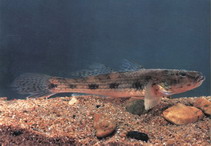Glossogobius giuris (Hamilton, 1822)
Tank goby |
|
Bia,
Bakla,
Bal-la,
Batug,
biya,
Biyang mapute,
Biyang puti,
Bunog,
Bunor,
Dapal,
Dolog,
Durogbatang,
Goby,
Ipon,
Kadurog,
Kapalo,
Pidianga,
Pijanga,
Sagunayon,
Tabula,
Tank goby,
Whitegoby
|
| Family: |
Gobiidae (Gobies), subfamily: Gobiinae |
| Max. size: |
50 cm SL (male/unsexed) |
| Environment: |
benthopelagic; freshwater; brackish; marine; depth range 0 - 5 m, amphidromous |
| Distribution: |
Africa to Oceania: Red Sea and East Africa, south to Transkei in South Africa, and most inland freshwater bodies over the Indian Ocean and western Pacific (Ref. 4343, 52193). Common in coastal and estuarine waters from austral Africa and Madagascar to India and south of China. |
| Diagnosis: |
Dorsal spines (total): 7-7; Dorsal soft rays (total): 8-9; Anal spines: 1-1; Anal soft rays: 8-9. Description: Head flattened, depressed; mouth large, lower jaw projecting (Ref. 4967, 52193). Dorsal fin with 7 spines and 9 soft rays; anal fin with 1 spine and 8 soft rays; pelvic fins jointed but attached to the body only from their anterior part; caudal fin bluntly or sharply pointed (Ref. 48660, 52193). Scales in lateral series 29-33; nape with visible scales; 15-19 predorsal scales (Ref. 52193). Colouration: Translucent brown with dark brown or black spots and blotches along back and forming a series along midbody; with 5 to 6 dark and rounded spots on its sides; some specimens living on dark substrates can be very dark also, some living on very light substrates show an ivory coloration; dorsal fins are light with small brownish spots forming longitudinal stripes; pelvic fins are grey; pectorals and caudal are grey and often hyaline (Ref. 2798, 48660, 52193). |
| Biology: |
Found mainly in freshwater and estuaries, but also enter the sea (Ref. 4833). Also occur in canals, ditches and ponds (Ref. 12693). Found in clear to turbid streams with rock, gravel or sand bottoms (Ref. 2847). Encountered in medium to large-sized rivers of the lower Mekong (Ref. 12975). Feed on small insects, crustaceans and small fish. Grow to a much larger size in brackish water than in fresh water. Marketed fresh (Ref. 12693). Cannibalism is relatively common for this species (Ref. 48660). |
| IUCN Red List Status: |
Least Concern (LC); Date assessed: 11 August 2019 Ref. (130435)
|
| Threat to humans: |
harmless |
| Country info: |
Abundant in Lake Taal, 1995 survey (Ref. 12165,13446), as part of gill net catch composition (Ref. 81207), collected from the lake in Laurel, Batangas as a living specimen (Ref. 81820). Found common in Laguna de Bay catch (Ref. 13460, 80824). Also found in the reservoirs of Lake Buhi and Binga (Ref. 13464); Lake Buluan (13492); Lake Naujan (Ref. 13446); Pampanga River, Paitan Lake and Pantabangan Dam (Nueva Ecija) (Ref. 109918). Museum specimens collected in 1983-4 from various localities, LRS-83111 (Ref. 13460). A local introduction. Migrated into Lake Mainit via the Tubay River, Mindanao (Ref. 4567, 50320, 13446, 81829), reported from Kalinawan River (Ref. 81829). Caused the extinction of 17 endemic cyprinid species and three genera of Lake Lanao (Ref. 12217, 13446, 81887). The loss of the endemic cyprinids has been attributed to the heavy predation by the species which was inadvertently stocked in the lake with Nile tilapia fingerlings coming from a government hatchery in Surigao del Norte (Ref. 48328). Also Ref. 5258, 41236, 48328, 95183. |
Source and more info: www.fishbase.org. For personal, classroom, and other internal use only. Not for publication.

